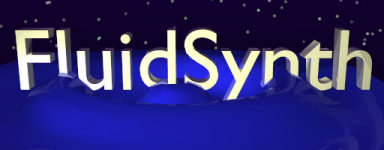 Logo created by Josh Green FluidSynth Introduction FluidSynth is a real-time software synthesizer based on the SoundFont 2 specifications. FluidSynth can read MIDI events from a MIDI input device and render them to an audio device using SoundFont instruments. SoundFont files are composed of digital audio "samples" and additional instrument parameters. These files can be created or downloaded off the Internet. FluidSynth also has support for controlling effects in real time and can play MIDI files. Note: FluidSynth was previously called IIWU Synth. Note The information on this web site is still incomplete. The user and developer documentation is very limited, and it lacks information for Mac and Windows users. Download The source code of FluidSynth can be obtained at the Savannah web site. The CVS repository is accessible here. Installation The installation of FluidSynth uses the standard automake tools. Do the standard suite of commands:
$ ./configure
$ make
$ make install
A more complete description can be found in the INSTALL file included in the project. Documentation The man page can be viewed here. The API documentation is available online here. Some additional documentation on using the FluidSynth API has been written by Conrad Berhörster which you can find here. Communication For any questions, comments, bug report, installation help or other, send an email to the fluid-dev mailing list. You can subscribe to the mailing list on the Savannah web site. Developers If you want to use sound effects in your application or you want to play music using samples, then you could consider using FluidSynth. Integrating the FluidSynth in your project is very easy. The interface is what you'd expect from a SoundFont synthesizer: noteon, noteoff, control_change, sfload, etc. The synthesizer was designed to be as self-contained as possible so there are no dependencies on other libraries. It is fairly small and fairly efficient. Off course, that will continue to improve over time ;) It's also important to note that FluidSynth runs on Linux, FreeBSD, Mac OSX, MacOS and Win32. History / Thanks The development of FluidSynth started when Johnathan Lee proposed to use SoundFonts for the IIWU project, an artistic, online, multi-user game initiated by Samuel Bianchini and Peter Hanappe. Peter Hanappe wrote the first version of the synthesizer and was later joined by Josh Green, Stéphane Letz, Markus Nentwig, and Antoine Schmitt. Many people have contributed to FluidSynth, by sending bug fixes and improvements, testing it, or packaging it. Please check the AUTHORS file in the distribution for an more complete overview. We would like to thank the Fondation Daniel Langlois for their funding. Their help made this project get of the ground. Without it, it would simply not exist. Applications Links to applications that use FluidSynth:
- Swami
(Sampled Waveforms And Musical Instruments) an
instrument patch editor and other side projects brought
to you by Josh Green Feel free to post an email to the mailing list if you know of any other applications that use FluidSynth. Links
- Check out the SoundFont database at HammerSound Disclaimer SoundFont(R) is a registered trademark of E-mu Systems, Inc. |
|||